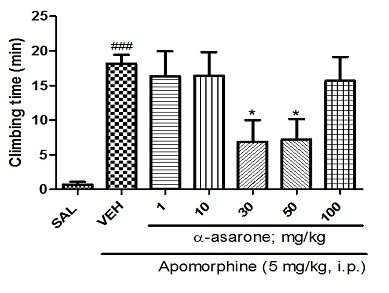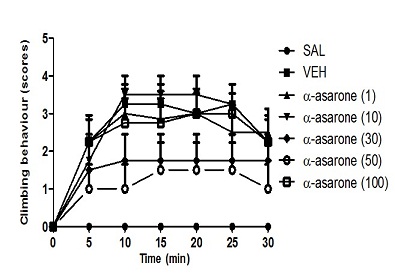
Citation: Pandy V and Vijeepallam K. Antipsychotic-Like Activity of α-Asarone in Mice: A Preliminary Report. Adv Pharmacol Clin Trials 2016, 1(1): 000106.
*Corresponding author: Vijayapandi Pandy, Department of Pharmacology, Faculty of Medicine, University of Malaya 50603 Kuala Lumpur, Malaysia, Tel: +60 3 7967 4712; Email:pandiphd@gmail.com
Alpha (α) - asarone is known to be one of the active compounds which have been discovered to be responsible for the therapeutic benefits of Acorus species. Previous studies have reported that Acorus calamus leaf extracts exerted the neuromodulatory effects on the nigrostriatal dopaminergic system. Therefore, the present study aimed to investigate the antipsychotic-like activity of α-asarone using a mouse model of apomorphine-induced stereotyped behaviour. Swiss albino male mice (bodyweight, 25-30g) were used for this study. In acute studies, α-asarone at different doses 1, 10, 30, 50, and 100 mg/kg bodyweight were administered orally one hour prior to apomorphine (5mg/kg, i.p.) injection respectively. Immediately after the injection of apomorphine, the mice were placed individually in cylindrical metal cages (18 cm in diameter and 19 cm in height) with the wall and floor consisting of vertical and horizontal metal bars and recorded for climbing time and climbing behaviour. The climbing behaviour was scored as 4 = four paws on the wall of the cage, 2 = two paws on the wall of the cage, 0 = four paws on the floor. The acute treatment of α-asarone (1-100 mg/kg, p.o.) exhibited an inverted bell-shaped dose-response in cage climbing behaviour. α-asarone at 30 and 50 mg/kg significantly decreased the apomorphine-induced cage climbing time and climbing behaviour in mice. These observed effects might be attributed due to the antidopaminergic property of α-asarone. Antagonism of dopamine D2 receptors is a common feature of the most clinically effective antipsychotic drugs, especially active against hallucinations and delusions. Overall, the present study uncovered the antidopaminergic effect of α-asarone; thereby α-asarone exhibited antipsychotic-like activity in mice. However, further neurochemical studies are warranted to explore the actual mechanism of action of α-asarone as a promising novel antipsychotic agent.
Keywords: α-asarone; Apomorphine; Cage climbing; Dopamine; Mice; Psychosis
According to the National Institute of Mental Health, psychosis is described as disturbance of a person’s thoughts and perceptions to the reality. The symptoms of psychosis are majorly classified as positive symptoms such as delusions, hallucinations and stereotyped behaviour, and negative symptoms such as anxiety, depression, sleep disturbances, social withdrawal, and lack of motivation. US FDA approved atypical antipsychotics are clozapine, risperidone, olanzapine, iloperidone, ziprasidone, asenapine maleate, lurasidone, fluoxetine, paliperidone, quetiapine, and aripiprazole. Although these newer atypical antipsychotics are very effective in treating both positive and negative symptoms, a growing body of evidences suggested a different set of side effects profile such as weight gain, hyperlipidemia, diabetes mellitus, and prolongation of QTc interval, myocarditis, sexual dysfunction, extra pyramidal side effects and cataract were observed in patients receiving atypical antipsychotics [1]. Thus a novel drug discovery for the effective treatment of psychosis with no or less adverse effects is an evergreen field in pharma research.
Recently, it has been given much importance to phytopharmaceuticals in novel drug discovery for the treatment of many diseases. α-asarone is a one among important phytopharmaceutical has been studied widely for various therapeutic benefits. It is a major bioactive compound, identified to be responsible for numerous pharmacological activities of Acorus species. The diverse neuropharmacological activities, such as anticonvulsant, antidepressant, anxiolytic, neuroprotective, and nootropic activities have been reported [2-5]. Recently, our research group reported the biphasic effect of α-asarone in a mouse model of tail suspension test in which antidepressant-like effect was observed at relatively lower doses (15 and 20 mg/kg, i.p.) and depressive-like activity at relatively higher doses (50 and 100 mg/kg, i.p.) [6]. In our earlier studies, Acorus calamus leaf extracts alleviated apomorphine-induced stereotypy and potentiated haloperidol-induced catalepsy in mice and demonstrated antipsychotic-like effect of Acorus calamus [7]. Moreover, our previous work revealed that Acorus calamus leaf extracts exerted the neuromodulatory effects on nigrostriatal dopaminergic system [8]. However to date there is no evidence elucidating the antipsychotic effect of α-asarone, a bioactive principle of Acorus calamus. Thus, the present study aimed to evaluate the antipsychotic effect of α-asarone using a mouse model of apomorphine-induced cage climbing behavior.
Material MethodsAnimals
Male Swiss albino mice weighing 25–30g were purchased from Laboratory animal centre, University of Malaya. Mice were housed and acclimatized in cages of four animals at a temperature and light controlled vivarium (22±1°C, 12-hlight-dark cycle, lights on/off- 7am/7pm). The animals were fed with standard food pellets and water ad libitum. Behavioural testing was conducted during the light phase. The experiments were conducted in accordance with the National Research Council of the National Academies of the USA (“Guide for the Care and Use of Laboratory Animals”) [9] and were approved by the Institutional Animal Care and Use Committee, University of Malaya, Kuala Lumpur (IACUC Ethics No. FAR/27/01/2012/PV (R)).
Drugs and administrationApomorphine hydrochloride (Sigma-Aldrich, USA) was dissolved in saline containing sodium metabisulphite (0.125% w/v); administered intraperitoneally (i.p.) 5mg/kg body weight in a constant volume of 1 ml/100 g body weight of the animal. α-asarone (Sigma-Aldrich, USA) was suspended in 1% w/v aqueous solution of sodium carboxymethyl cellulose (CMC) administered orally (p.o.).
Apomorphine-induced climbing behaviour in miceThe apparatus, procedure, and scoring pattern used to evaluate the climbing behaviour were the same as described in our previous study [10]. In acute studies, α- asarone at different doses 1, 10, 30, 50, and 100 mg/kg, were administered orally one hour prior to apomorphine (5mg/kg, i.p.) injection respectively. Immediately after injection of apomorphine, the mice were placed individually in cylindrical metal cages (18 cm in diameter and 19 cm in height) with the floor and wall consisting of vertical and horizontal metal bars and recorded for climbing time and climbing behaviour. The climbing behaviour was scored as 0 = four paws on the floor, 2 = two paws on the wall of the cage, and 4 = four paws on the wall of the cage.
Statistical analysisThe comparisons among different groups were made using one way analysis of variance (ANOVA) followed by Dunnett’s multiple comparison tests. The data were expressed as mean ± SEM, and analyzed using Graph Pad Prism version 5.0 statistical software. A level of p < 0.05 was considered as statistically significant.
Results and Discussion Effect of α-asarone on apomorphine-induced climbing behaviour in miceAcute oral treatment of α-asarone at different doses (1, 10, 30, 50, and 100 mg/kg body weight) demonstrated the inverted bell-shaped dose response in apomorphineinduced cage climbing time [F (6, 49) = 5.467; p< 0.0002] and climbing behaviour index [F (6, 49) = 5.446; p< 0.0002] in mice as shown in Figures 1a, 1b and 1c. α- asarone (30, and 50 mg/kg, p.o.) significantly (p< 0.05) inhibited apomorphine-induced cage climbing time and climbing behaviour in mice.
It has been reported that acute administration of apomorphine induced the stereotyped behaviours [11], locomotor activity, rearing/grooming [12] and cageclimbing behaviours [10, 13] in rodents. Apomorphine is a non-selective dopamine agonist which activates postsynaptic mesolimbic D2 and D1 dopamine (DA) receptors. Apomorphine-induced climbing behaviour is one of a well-known animal model of psychosis to study the postsynaptic DA receptors in the brain [14, 15]. It has been proposed that activation of both D2 and D1-dopamine (DA) receptors are required to induce climbing behaviour in rodents. Quinpirole (selective D2 agonist) and SKF38393 (selective D1 agonist) per se failed to induce cage climbing behaviour, but in combination of D2 and D1 agonists induced climbing behaviour. However, either D2 antagonists or D1 antagonists per se alleviated apomorphine-induced climbing behaviour [16]. Therefore, attenuation of apomorphine-induced climbing behaviour in rodents suggesting the antipsychotic-like effect of the given compounds by inhibition of D1 and/or D2 receptors. In present study, acute oral doses of α- asarone at 30 and 50 mg/kg significantly decreased the apomorphine-induced cage climbing time and climbing behaviour in mice. Therefore, it has been postulated that the observed antipsychotic-like effect of α-asarone might be attributed to blockade of dopaminergic D2 and/or D1 receptors in the brain.
ConclusionOverall, the present study revealed the antidopaminergic activity of α-asarone; thereby α- asarone exhibited the antipsychotic-like activity in mice. However, further neurochemical studies are warranted to explore the actual mechanism of action of α-asarone as a promising novel antipsychotic agent.
Competing InterestThe authors declare that they have no competing interests.
Author’s ContributionK.V performed the experiments, accomplished the data analysis and drafted the manuscript; V.P conceived, and designed the study and co-drafted the manuscript.
AcknowledgementThis study was supported by the University of Malaya Research grants (RG495-13HTM) and HIR MOHE Project No: UM.C/625/1/HIR/MOHE/MED/05 (H-20001- E000088).



Figure1: Effect of α-asarone (mg/kg, p.o.) on cage climbing time and climbing behavior induced by apomorphine in mice. Figure 1(a) Total time spent on the wall of the cage
Figure 1(b) Climbing behaviour scores at different time points for 30 min
Figure 1(c) The cumulative scores that measured for 30 min after administration of apomorphine. All data represents as mean ± SEM from eight animals. ### p<0.001, when compared with the saline group; * p< 0.05 when compared with the vehicle group.
Chat with us on WhatsApp